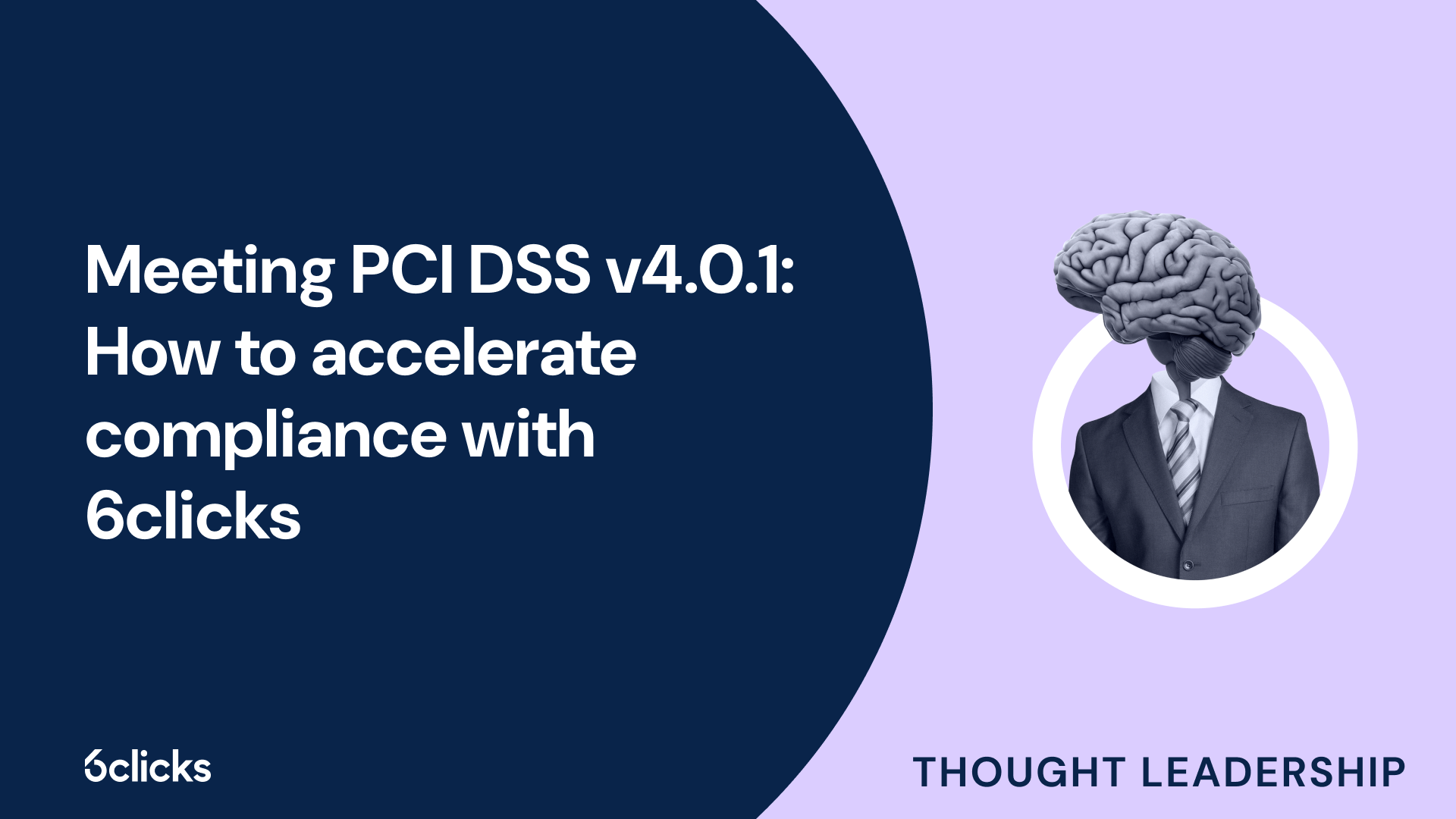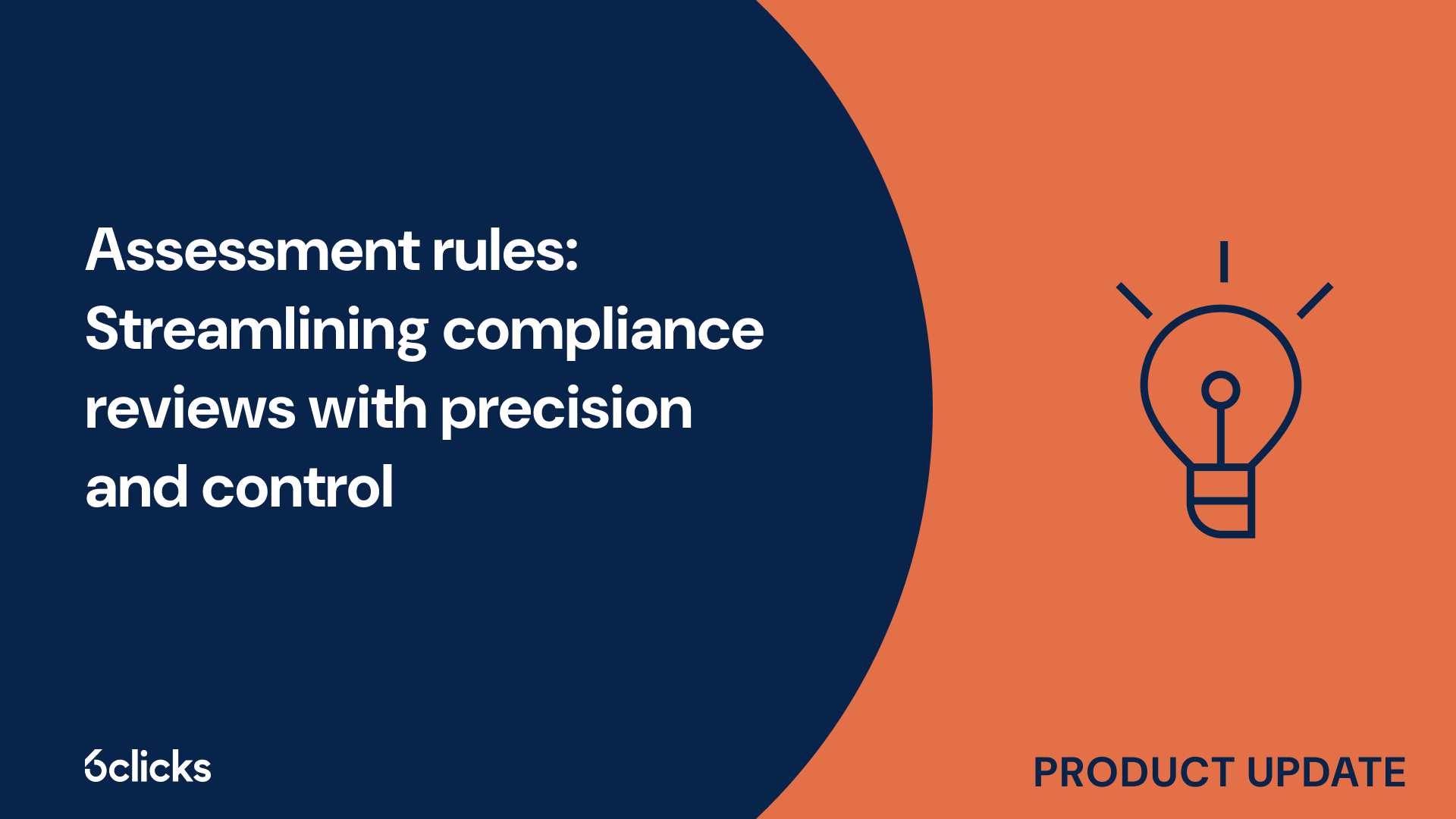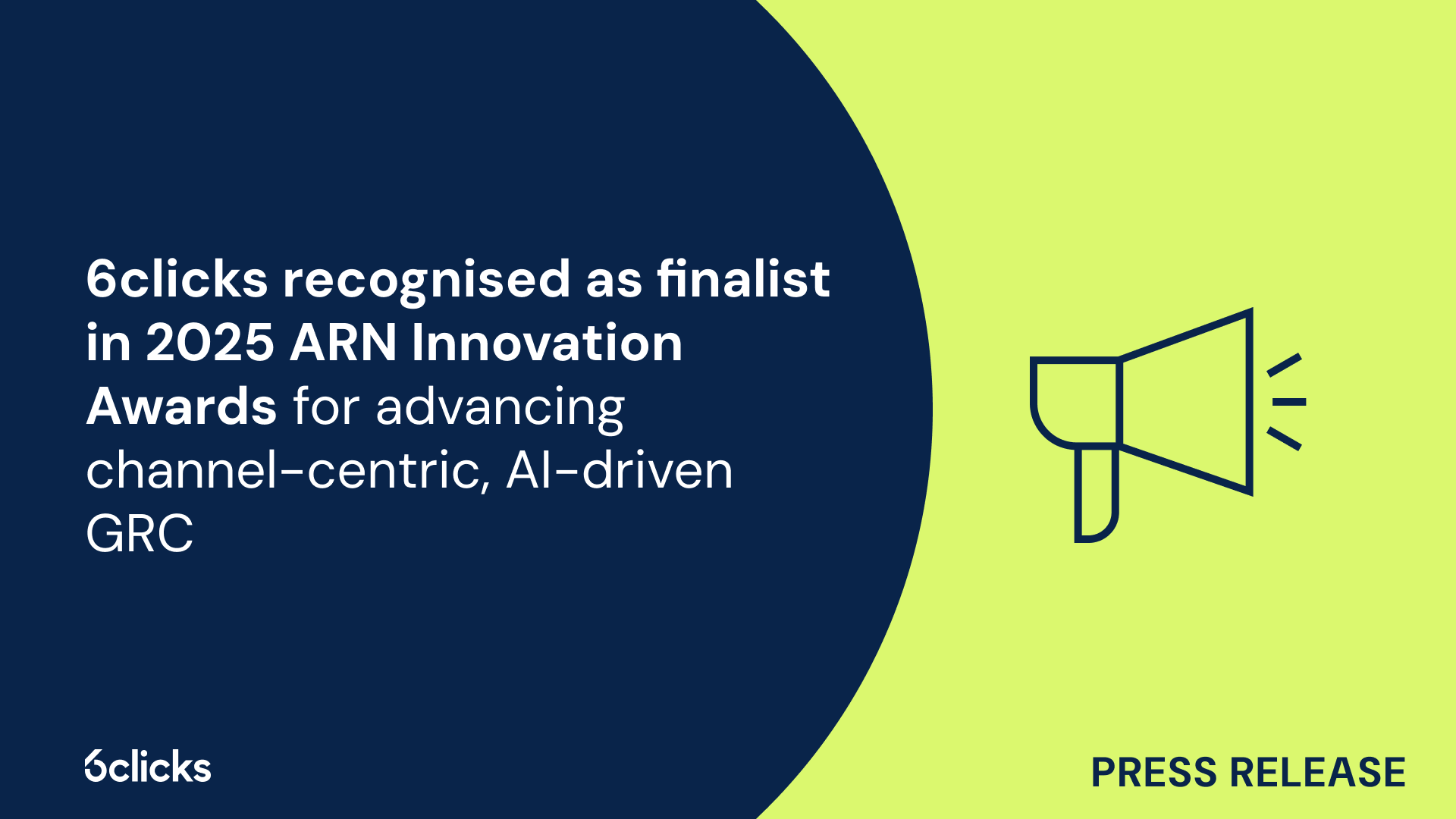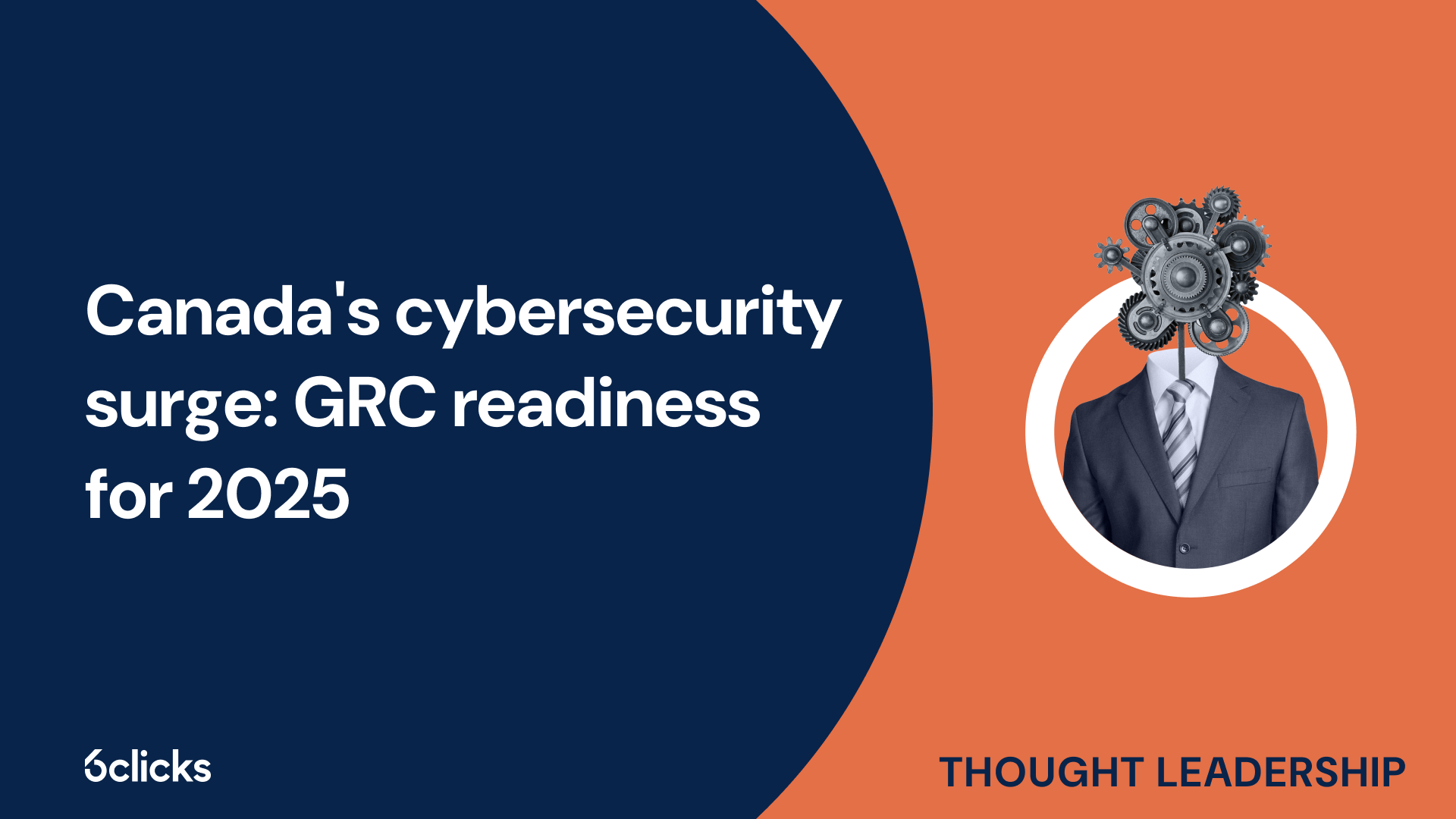The GRC buyer’s guide for 2025: Building resilience with AI-powered, federated solutions
Discover the ultimate GRC buyer's guide for 2025! Uncover how AI-powered, federated solutions transform compliance and security management for industries like government, aerospace, banking, and more. Learn about centralized control, continuous compliance, and advanced cyber GRC capabilities. Download now!
-1.png?width=200&height=249&name=Group%20193%20(1)-1.png)
The GRC buyer’s guide for 2025: Building resilience with AI-powered, federated solutions
Overview of ISO/IEC 27001
ISO/IEC 27001 is an international standard that sets out the criteria for implementing, maintaining, and continuously improving an Information Security Management System (ISMS). The ISMS is a systematic approach to managing sensitive company information, ensuring its confidentiality, integrity, and availability. ISO/IEC 27001 provides a framework of security controls and management requirements that organizations can use to establish their own security management systems. It covers a wide range of security aspects, including risk management, physical security, access controls, communication security, and more. ISO/IEC 27001 certification involves a certification audit by an independent certification body to assess the organization's compliance with the standard. By obtaining ISO/IEC 27001 certification, organizations demonstrate their commitment to security, improve their cybersecurity posture, and enhance their ability to protect against security threats and incidents. It also helps organizations to comply with regulatory requirements and boost customer confidence in their security measures. With ISO/IEC 27001, organizations can effectively manage their information security risks and reap the benefits of a robust security management system.
Overview of ISMS
An Information Security Management System (ISMS) is a systematic approach to managing an organization's information security risks. It provides a framework for establishing, implementing, operating, monitoring, reviewing, maintaining, and improving the security of information assets. The International Organization for Standardization (ISO) has developed ISO 27001 as the standard for ISMS.
ISO 27001 sets out the criteria for implementing, maintaining, and continuously improving an ISMS within the context of an organization's overall business risks. By adopting ISO 27001, organizations can establish comprehensive security policies, procedures, and controls that safeguard their sensitive information from a wide range of threats and vulnerabilities.
An ISMS helps organizations secure their information assets by implementing a range of security measures. These include policies that outline the organization's commitment to information security, procedures that define how security is to be managed, and controls that enforce the necessary security requirements.
One of the key elements of an ISMS is the risk assessment process. This involves identifying and assessing the risks to the organization's information assets, and then implementing appropriate controls to mitigate those risks. The ISMS also includes a technology-neutral approach, ensuring that the security measures can adapt to changes in technology and threats over time.
Another important component of an ISMS is employee behavior. Through training and awareness programs, organizations can educate their employees on the importance of information security and the role they play in safeguarding the organization's sensitive data.
What is the difference between ISO/IEC 27001 and ISMS?
ISO/IEC 27001 and ISMS are closely related but distinct concepts in the field of information security management. ISO/IEC 27001 is an international standard that outlines the requirements for establishing, implementing, maintaining, and continually improving an Information Security Management System (ISMS). In other words, ISO/IEC 27001 provides a framework and criteria for organizations to develop an effective ISMS. On the other hand, ISMS refers to the actual system or set of processes and controls that an organization implements to manage and mitigate information security risks. While ISO/IEC 27001 guides the implementation of an ISMS, ISMS represents the practical application of the standard within an organization. Therefore, ISO/IEC 27001 can be seen as the roadmap or blueprint for building an ISMS, while ISMS is the tangible outcome of implementing the standard's requirements. By adhering to ISO/IEC 27001, organizations can establish a robust and comprehensive ISMS that addresses their specific information security risks and protects sensitive data from potential threats.
Security objectives & policies
In order to effectively manage complex security systems and respond to evolving security threats, it is crucial to establish security objectives and policies within an Information Security Management System (ISMS).
Security objectives serve as the overall goals and targets that an organization aims to achieve in terms of safeguarding its information assets. These objectives should align with the organization's overall business objectives and take into consideration the specific risks and needs of the organization. By defining clear and measurable security objectives, organizations can focus their efforts on proactively addressing vulnerabilities and mitigating security risks.
On the other hand, security policies provide a framework for guiding employees and stakeholders in their behaviors and actions related to information security. These policies outline the rules, procedures, and best practices that must be followed to ensure the confidentiality, integrity, and availability of information assets. They serve as a set of guidelines that individuals and teams can refer to when making decisions or handling sensitive information.
The establishment of security objectives and policies within an ISMS enables organizations to take a proactive and systematic approach to managing and improving their security posture. By regularly reviewing and updating these objectives and policies, organizations can stay ahead of evolving security threats and adapt their security controls and measures accordingly. This ongoing commitment to security helps maintain the confidentiality, integrity, and availability of sensitive information assets while ensuring compliance with relevant laws, regulations, and industry standards.
Risk assessment & management processes
In ISO/IEC 27001, risk assessment and management processes play a crucial role in ensuring the effective implementation and maintenance of security controls. Regular information security risk assessments are conducted to identify and evaluate potential risks to information assets. These assessments involve a systematic approach to identify risks, analyze their potential impacts, and determine appropriate risk treatment processes.
During a risk assessment, organizations assess the likelihood and impact of identified risks on the confidentiality, integrity, and availability of information assets. This helps in prioritizing risks based on their potential impact and likelihood of occurrence. The risk assessment process considers both internal and external factors that may pose a threat to the organization's information security.
ISO/IEC 27001 introduces four options for treating risks: modification, retention, avoidance, and sharing. Organizations may choose to modify the risk by implementing security controls to reduce the likelihood or impact of a risk. Alternatively, they may choose to retain the risk if it is deemed acceptable or unavoidable. Another option is to avoid the risk altogether by changing processes or eliminating the activity that poses the risk. Finally, organizations may choose to share the risk with third parties through contracts or insurance.
In addition to risk treatment, ISO/IEC 27001:2022 also introduces two options for treating opportunities: enhancement and exploitation. Organizations can enhance opportunities by implementing measures to maximize their potential benefits. They can also exploit opportunities by taking proactive steps to capitalize on them.
ISO/IEC 27001 provides a comprehensive framework for conducting risk assessments and managing risks. Organizations can refer to Annex A controls for guidance in implementing specific security controls to address identified risks. By regularly conducting risk assessments and implementing appropriate risk treatment measures, organizations can maintain a robust information security posture and mitigate potential vulnerabilities.
Systematic approach to data security
The systematic approach to data security is a fundamental aspect of both ISO/IEC 27001 and ISMS (Information Security Management System). These standards establish a structured and methodical framework for organizations to manage and protect their valuable information assets.
By adopting a systematic approach, organizations can ensure that data security measures are implemented consistently across all areas of the business. This approach involves conducting a thorough risk assessment to identify potential vulnerabilities and threats to data security. Based on this assessment, appropriate security controls are established to mitigate these risks.
A process approach is crucial for establishing effective security controls and responsibilities. It involves defining and implementing a series of interconnected processes that collectively form the ISMS. These processes encompass activities such as risk assessment, security incident management, access control, and employee awareness training.
In this context, clear definition of roles and responsibilities becomes essential. It is important to clearly identify who is responsible for what, and when, in order to ensure that security controls are implemented and maintained effectively. This includes ensuring that employees understand their individual responsibilities for data security and are equipped with the necessary knowledge and tools to fulfill their roles.
Physical security requirements
Physical security requirements play a critical role in the implementation of an Information Security Management System (ISMS) aligned with ISO/IEC 27001. These requirements focus on safeguarding the physical assets, facilities, and sensitive information of an organization from unauthorized access, theft, damage, or loss.
Physical security measures contribute significantly to the overall security posture of an organization by providing an additional layer of protection to its sensitive information. By implementing robust physical security controls, organizations can reduce the risk of physical threats and unauthorized access, thereby ensuring the confidentiality, integrity, and availability of their data.
ISO/IEC 27001 recommends several key physical security controls and techniques as part of the ISMS framework. These controls include secure access controls, like the use of access cards, biometric authentication, or combination locks. Implementing surveillance systems, such as CCTV cameras and security guards, enables continuous monitoring and detection of any unauthorized activities. Creating secure environments by installing alarm systems, motion detectors, and physical barriers further enhance the protection of sensitive areas or assets.
By incorporating these physical security controls into their ISMS, organizations can demonstrate their commitment to maintaining the confidentiality, integrity, and availability of sensitive information. This ensures that potential breaches are deterred, detected, and responded to promptly, bolstering their overall security posture.
Internal auditing & certification processes
Internal auditing and certification processes play crucial roles in ensuring the effectiveness and compliance of security management systems like ISO/IEC 27001 and ISMS.
Internal auditing involves the systematic examination of an organization's security controls, policies, and procedures to evaluate their adequacy and effectiveness. It is conducted by internal auditors who are independent of the area being audited. The purpose of internal audits is to identify any gaps or deficiencies in the organization's security management system and to provide recommendations for improvement.
On the other hand, the certification process involves an external certification body evaluating an organization's security management system against the requirements of ISO/IEC 27001 or ISMS. The certification audit is an independent assessment conducted by certified auditors. The aim of the certification audit is to determine whether the organization's security management system meets the requirements of the standard, and if so, to issue a certification attesting to its compliance.
The certification body, also known as the registrar, is responsible for conducting the certification audit. They will review the organization's documentation, conduct interviews, and perform site visits to verify compliance. The certification body must be accredited and comply with relevant certification criteria.
Continual improvement is a key aspect of ISO/IEC 27001 and ISMS. After each audit, organizations are required to address any identified non-conformities and take corrective actions. The organization's commitment to addressing these findings demonstrates its dedication to security and continual improvement.
Global applicability of standards
ISO/IEC 27001 is a globally recognized information security management standard that is applicable to organizations of all types and sizes, regardless of industry or geographical location. Its global applicability lies in its flexible and adaptable framework, which allows organizations to tailor information security controls to their unique needs.
The standard provides a systematic approach for managing and protecting sensitive information, ensuring the confidentiality, integrity, and availability of data. ISO/IEC 27001 emphasizes a risk-based approach to information security, enabling organizations to identify and assess security risks and implement appropriate controls to mitigate them.
One of the key benefits of ISO/IEC 27001 is its flexibility. It does not prescribe specific controls, but rather focuses on establishing an information security management system (ISMS) that aligns with the organization's objectives and requirements. This allows organizations to select and implement controls that are relevant to their specific environment, taking into consideration factors such as industry regulations, technological advancements, and organizational culture.
Another advantage of ISO/IEC 27001 is its ability to transcend geographical boundaries. Whether an organization operates in North America, Europe, Asia, or any other region, ISO/IEC 27001 provides a comprehensive framework that can be tailored to meet local requirements while maintaining global best practices in information security management.
Continual improvement focus
Continual improvement is a crucial aspect of ISO/IEC 27001 and an integral part of an effective Information Security Management System (ISMS). It emphasizes the need for organizations to constantly review and enhance their security controls, ensuring that their information security measures remain robust and responsive to ever-evolving threats.
By maintaining a continual improvement focus, organizations can enjoy several benefits. Firstly, it helps them stay ahead of emerging security risks and vulnerabilities. As technology advances and new security threats emerge, organizations need to regularly assess their security controls and update them accordingly. This proactive approach minimizes the likelihood of security incidents and strengthens an organization's overall cybersecurity posture.
Secondly, continual improvement supports the long-term effectiveness of an organization's ISMS. Conducting regular internal audits enables organizations to identify any gaps or weaknesses in their security controls and take corrective actions promptly. It ensures that the ISMS remains aligned with the organization's objectives and adapts to changes in the internal and external environment.
Furthermore, continual improvement fosters a culture of security awareness and commitment within the organization. By encouraging regular reviews and updates of security controls, employees become more engaged and proactive in safeguarding sensitive information. This collective commitment to security enhances the effectiveness of the ISMS and strengthens the organization's resilience against security threats.
Annex A Controls & security techniques
Annex A Controls in ISO/IEC 27001:2022 provide organizations with a comprehensive set of security techniques to address various security risks. The latest version of ISO/IEC 27001 introduces 11 new controls to enhance the security framework.
- Cloud services: This control helps organizations securely adopt and utilize cloud services, ensuring the confidentiality, integrity, and availability of their data stored or processed in the cloud.
- ICT readiness for business continuity: This control focuses on ensuring that information and communication technology (ICT) systems are prepared to support business continuity activities, including disaster recovery and incident response.
- Threat intelligence: Organizations are advised to implement this control to gather information on emerging security threats, analyze potential risks, and take proactive measures to protect their systems and data.
- Physical security monitoring: This control emphasizes the need for monitoring physical security measures, such as surveillance cameras, access controls, and alarms, to identify and respond to security incidents effectively.
- Data masking: This control involves the use of techniques to replace sensitive data with fictitious or altered data, protecting the confidentiality of information during testing, development, or outsourcing activities.
- Information deletion: This control ensures that residual information stored in hardware or media is properly deleted or sanitized to prevent unauthorized access and mitigate the risk of data breaches.
- Data leakage prevention: Organizations are required to implement this control to detect and prevent the unauthorized transmission of sensitive data through various channels, including email, instant messaging, or removable media.
- Monitoring activities: This control focuses on monitoring critical activities, such as privileged user access, system changes, and security events, to detect and respond to any unusual or suspicious behavior promptly.
- Web filtering: This control involves the implementation of filtering mechanisms to restrict access to malicious websites and inappropriate content, reducing the risk of web-based attacks and unauthorized access.
- Secure coding: This control emphasizes the use of secure coding practices to develop and maintain secure software, reducing the risk of software vulnerabilities and potential exploits.
These new controls in Annex A further strengthen an organization's security management system by addressing emerging security challenges and providing guidance on implementing effective security techniques. By incorporating these controls, organizations can enhance their cybersecurity posture and better protect their sensitive information.
Security frameworks & standards used by organizations
Organizations across various industries rely on security frameworks and standards to establish effective information security management practices. These frameworks and standards provide a structured and systematic approach to identifying, assessing, and mitigating information security risks. They also help organizations implement controls and procedures to protect sensitive data and prevent security breaches.
Some commonly used security frameworks and standards adopted by organizations include:
- ISO/IEC 27001: This international standard outlines the requirements for establishing, implementing, maintaining, and continually improving an information security management system (ISMS). It provides a comprehensive framework for managing security risks and ensuring the confidentiality, integrity, and availability of information.
- NIST Cybersecurity Framework: Developed by the National Institute of Standards and Technology (NIST) in the United States, this framework provides a set of security controls, guidelines, and best practices to help organizations manage and improve their cybersecurity posture. It offers a flexible and adaptive approach to managing cybersecurity risks.
- COBIT (Control Objectives for Information and Related Technologies): COBIT is a framework developed by the Information Systems Audit and Control Association (ISACA) that helps organizations govern and manage their IT processes and resources. It provides a comprehensive set of controls and guidance for aligning IT with business objectives and ensuring effective information security management.
- CIS Critical Security Controls: The Center for Internet Security (CIS) Critical Security Controls provides a prioritized list of security measures that organizations can implement to enhance their cybersecurity defenses. These controls are designed to address the most common and prevalent threats organizations face and serve as a baseline for cybersecurity best practices.
These security frameworks and standards play a vital role in ensuring effective information security management by providing organizations with guidance, best practices, and a benchmark for measuring their security posture. They help organizations identify and address security risks, implement appropriate security controls, and maintain regulatory compliance. By adopting these frameworks and standards, organizations can enhance their security resilience, protect their sensitive assets, and maintain the trust of their stakeholders.
Attestation report for compliance with ISO/IEC 27001:2022
An attestation report for compliance with ISO/IEC 27001:2022 plays a crucial role in the certification process of the ISO 27001 standard. This report serves as a means of verifying an organization's compliance with the requirements outlined in ISO/IEC 27001:2022, which is the latest version of the international standard for information security management systems (ISMS).
The purpose of this attestation report is to provide an independent evaluation of the organization's ISMS and its alignment with the criteria set forth in ISO/IEC 27001:2022. It is typically prepared by a certification body or external auditors who have expertise and knowledge in the field of information security management.
The attestation report serves as a reliable and credible document that attests to the organization's compliance with the ISO standard. It provides valuable assurance to stakeholders, such as clients, partners, and regulatory bodies, that the organization has implemented effective security controls and practices to protect sensitive information and mitigate security risks.
By obtaining this attestation report, organizations can demonstrate their commitment to security and their dedication to meeting international standards for information security management. It serves as a key component of the certification process, providing a validation of the organization's adherence to the requirements of ISO/IEC 27001:2022. Overall, the attestation report for compliance with ISO/IEC 27001:2022 is an essential tool for organizations seeking to establish their credibility and trustworthiness in the realm of information security.
Different types of certification audits available for organizations
Different types of certification audits are available for organizations to demonstrate their commitment to security and compliance standards. Two commonly sought-after certifications are ISO 27001 and SOC 2.
ISO 27001 is an internationally recognized standard for information security management systems (ISMS). The certification audit for ISO 27001 is conducted by an accredited certification body. It evaluates the organization's compliance with the standard's requirements, including risk assessment, security controls, and continual improvement. The audit process involves a thorough review of documentation, assessments of the ISMS implementation, and interviews with key personnel.
On the other hand, SOC 2 is an attestation report issued by an external auditor. It evaluates an organization's controls related to security, availability, processing integrity, confidentiality, and privacy. SOC 2 focuses more on service organizations and their data protection practices. Documentation includes a system description and a list of compliance requirements. The audit process may involve testing of controls, walkthroughs, and discussions with relevant stakeholders.
Both ISO 27001 and SOC 2 certifications require ongoing commitment to security and compliance. This entails regular internal audits, risk assessments, updates to policies and procedures, and continuous improvement of the management system. These certifications demonstrate an organization's diligence and commitment to protecting sensitive data and ensuring the security and privacy of their systems and processes.
Benefits of implementing an ISO/IEC 27001-compliant ISMS
Implementing an ISO/IEC 27001-compliant Information Security Management System (ISMS) provides organizations with several benefits in terms of information security and meeting stakeholders' expectations. By adopting this systematic approach, organizations can strategize and coordinate their security investments effectively, ensuring the protection of valuable information assets and maintaining stakeholder confidence.
One of the key advantages of implementing an ISO/IEC 27001-compliant ISMS is the implementation of targeted controls and risk treatment methods. Through a comprehensive risk assessment process, organizations can identify and prioritize potential threats and vulnerabilities. By implementing appropriate controls, such as access controls, encryption technologies, and incident response procedures, organizations can significantly reduce the likelihood and impact of security incidents. This proactive approach helps in safeguarding sensitive company and customer information, mitigating financial and reputational risks.
ISO/IEC 27001 also enables organizations to set clear objectives for information security and align them with business goals. This ensures that information security initiatives are in line with the organization's overall strategy. By defining security requirements and policies, organizations can build a culture of security awareness and compliance, ensuring that all employees understand their roles and responsibilities in protecting information assets.
Another benefit of ISO/IEC 27001 is its focus on continuous measurement and improvement. Regular internal audits and management reviews help organizations monitor and evaluate the effectiveness of their ISMS. By analyzing security incidents, conducting gap analysis, and implementing corrective actions, organizations can continuously enhance their cybersecurity posture. This iterative process ensures that the ISMS remains relevant and effective in addressing emerging security threats and evolving stakeholder expectations.







